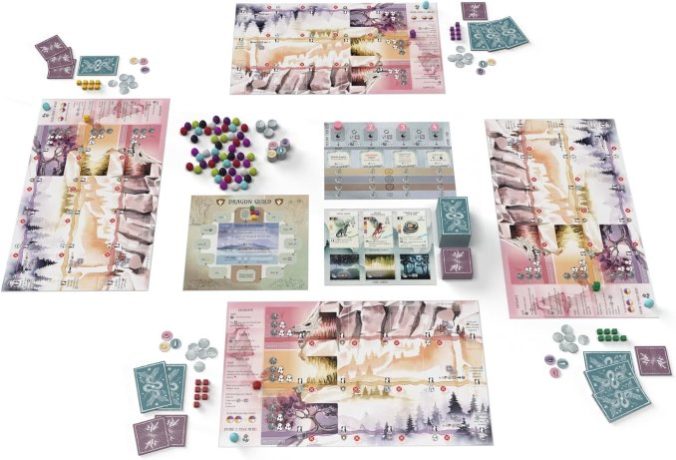Wingspan is one of the best and most successful tabletop games in history, surpassing one million copies sold in less than five years on the market even at a price point well above what American consumers are used to paying for Monopoly or Clue. It was the first game I ever awarded a perfect grade of 10, still just one of two (along with Heat: Pedal to the Metal), and it’s still among my favorites even after dozens and dozens of plays.
Sequel games, however, usually leave me pretty cold; at least they do if I love the original. You can tweak a game a little to address some rules imbalances, but as a general rule I stick with base games and look askance at attempts to cash in through reskins, rethemes, or “inspired by” versions.
So the immovable object meets the irresistible force with Wyrmspan, a new game built on the mechanics and framework of Wingspan, but in lieu of birds, here be dragons. From the designer of Apiary (Connie Vogelmann), with credit to Wingspan’s designer Elizabeth Hargrave, Wyrmspan borrows much of the bones of its predecessor, but makes several significant changes to create a new, slightly harder, and—most importantly—fun game that does, in fact, add something that even serious Wingspan players will appreciate.
As in Wingspan, players will play cards from their hands to three different rows on their personal player boards, paying some combination of resources printed on the card to do so. Players may also take actions that activate all of the cards and some spaces in any single row, picking up resources, laying eggs on cards, or gaining other benefits. There are four rounds, with one public objective card to score after each round. After the fourth round, players add up all of the points shown on cards they’ve played, plus one point per egg, any points from food cached on cards or cards tucked under others, points from round objectives, and one or two other little sources to determine the winner.
If you’ve played Wingspan, you’ll have very little trouble getting the hang of Wyrmspan, even with its differences. One of the biggest is that your number of actions for a round doesn’t decrease from the round before; you get six coins for each round and will spend one for each basic action, with some ways to get an additional coin for the current round and some cards you’ll play that require a second coin as payment. Another is that your player board has 12 spaces for cards instead of 15, but at the start of the game, only three are “excavated” and can take dragon cards. You must excavate all others by playing cave cards, which costs a coin plus one egg or two for the two right-most columns. You do get an immediate bonus for playing any cave card, which can range from free resources to a coin to playing a dragon card at a discount to drawing two dragon cards.

The three basic actions in Wyrmspan are Entice (tempt a dragon into your cave, which I admit now sounds a bit risqué), Excavate (play a cave card), and Explore (move your adventurer across an entire row). Playing a dragon card is simple—you can only play to an excavated space, you must play a dragon to a row it likes (shown on the left side of the card), and you must pay the cost, which can be any combination of the game’s four resources, eggs, or even a coin. Excavate is also quite simple, although you do have to gain cave cards throughout the game; you start with four cards in total between dragons and caves, but picking up both must be part of your strategy.
Exploring is where the magic happens, and I apologize if my mind appears to be stuck in some sort of dragon gutter. You move your adventurer left to right, the opposite direction from Wingspan, and not only do you activate any cards with a power on them, you also gain something from the spaces before, between, and after each played dragon card, stopping only when you get to either an empty space or a cave without a dragon.
The benefits you gain from adventuring, from activating or playing cards, from caves, and so on are mostly familiar ones—gain resources, draw cards, lay eggs—with one new one, movement around the dragon guild track. There’s a separate board with a circular track and one of four guild cards in the center. When you move your token around the guild track, you gain something at each step, until you reach the top or bottom spaces (think noon or 6 o’clock), at which point you take one of your markers and place it on the guild card for either an immediate benefit/action or a game-end points bonus. It’s particularly important in the solo game against an Automa player, as its marker speeds around the track and picks up more points as the game progresses, but you can also make the guild track a key part of your strategy in a competitive game. It’s the one part of Wyrmspan that doesn’t really fit for me—it feels tacked-on, and isn’t well integrated with anything else in the game, either the mechanics or the theme. (Dragons have guilds? Do they practice a trade? I suppose they need good dental.)
If you have and love Wingspan, do you need Wyrmspan? I mean “need” in the real sense, not in the toddler sense, where they need anything they want, which is generally how I approach board game acquisition as well. Wingspan has three expansions that bring new bird cards and some rules tweaks; Wyrmspan changes the game at a more fundamental level. It also is a stunner on the table—these are some fine-lookin’ dragons—and is extremely well-made, like all products from Stonemaier Games. I lean towards “yes” to the question of whether you need it—it’s too good a game to pass over if you already love the basics of the original, the way I’d still say you should get at least one Azul sequel if you love the first one like I do. Just make some more room in your games cave next to the original.
Keith Law is the author of The Inside Game and Smart Baseball and a senior baseball writer for The Athletic. You can find his personal blog the dish, covering games, literature, and more, at meadowparty.com/blog.

